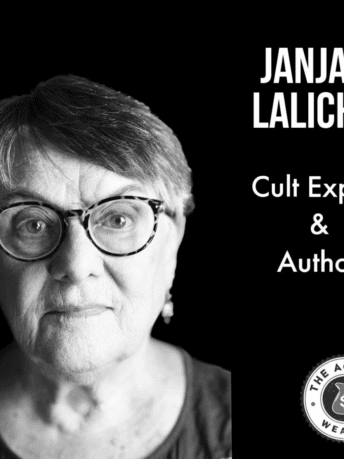On the Brainwashing Controversy by Janja Lalich, Ph.D. DO NOT CITE OR REPRINT WITHOUT AUTHOR’S PERMISSION
Thanks to the disinformation being spread far and wide, and now most especially on the Internet, many professionals and laypersons interested in issues related to psychological influence, extremism, new religious movements, and cultic groups are being confused by several assertions put forth time and again by cult spokespeople and their supporters. I write this with the hope of bringing some clarity to these issues, and to encourage further discussion.
Let’s Look at the Facts
One assertion continually heard is that the American Psychological Association (APA) and the American Sociological Association (ASA) “do not support theories on thought reform.” Just the other day, for example, I read a report written by an associate professor of religion that was sent to the media, among others. It stated that these “distinguished organizations [the APA and ASA]…no longer accept the model under which the word [brainwashing] first appeared.” This type of statement is misleading and is one of many efforts to denigrate by innuendo. It implies that these organizations at some point found fault with the brainwashing model, which is simply not the case because, as organizations, the APA and the ASA are not in the business of endorsing or rejecting theories.
First, one must understand that the APA and the ASA are two membership organizations, which professionals in their respective fields may join for an annual fee.
Both organizations have thousands of members and numerous divisions, committees, and subcommittees; both sponsor annual meetings, where papers are presented and theories and viewpoints are discussed and debated.
In order to inquire about this controversy, I phoned the APA and was directed to the Public Affairs office. The representative there told me explicitly and officially that the APA has no position on thought reform, coercive persuasion, or brainwashing, and that there has never been a position. The APA spokesperson explained that in the 1980s a Task Force report related to this topic was not accepted because it was not clear. But, he said, “that is not the same as saying the APA has a position,” and to do so would be a “misstatement.” Similarly, the representative in the Research Office, when asked if the APA had a position on brainwashing, said, “I don’t know of any such position.” In a call to the ASA, I was told by both the Executive Officer and Deputy Executive Officer that the ASA is a membership organization, does not advocate one theory over another, and does not take positions on theories. The Executive Officer specifically replied that the “ASA Council took no position on this issue when it considered it in August 1989.”
Could it be that those who wish to silence critics and do damage control for groups that are perhaps crossing the line of decency when it comes to influencing their recruits and members are deliberately mixing apples and oranges in hopes of distributing a fruit cocktail that will sour any taste for further inquiry?
Second, the Diagnostic and Statistical Manual of Mental Disorders (DSM-IV), the recently-updated manual, in which most therapists are trained and which is published by the American Psychiatric Association (1994), includes the concepts “brainwashing” and “thought reform” in its explanation of causes of one type of Dissociative Disorder. It also states that brainwashing and thought reform are examples of “periods of prolonged and intense coercive persuasion” (p. 490). This manual is used by mental health professionals around the country, and presumably most are members of the psychological association.
Third, as recently as 1997 the American Psychological Association Monitor, the APA’s monthly paper, published a full-page commentary by Dr. Philip Zimbardo (1997), a respected and well-known social psychologist at Stanford University, in which he writes about “cult mind control,” a popularly-used term for the thought-reform concept.
(Note: Recently, Zimbardo was elected president of the APA; his term is now over.) Similarly, psychiatrist Robert Lifton (1991) recently wrote an article about cult formation for The Harvard Mental Health Letter (a reputable and widely read publication).
Referring to his studies of both Chinese thought reform and the psychology of Nazi doctors, Lifton wrote, “Certain psychological themes which recur in these various historical contexts also arise in the study of cults.” He went on to describe his thoughtreform schema. Lifton and his thought-reform concept were also reported on in the American Psychiatric Association’s monthly paper, Psychiatric News, in an article entitled, “ ‘Totalism’ Ideology of Cults Helps Explain Violent Acts” (1997).
And finally, books describing totalist cults, thought-reform processes, intense persuasion techniques, and their impact on the individual and, at times, on our society, such as Combatting Cult Mind Control (Hassan, 1986), Recovery from Cults (Langone, 1993), Captive Hearts, Captive Minds (Tobias & Lalich, 1994), and Cults in Our Midst (Singer & Lalich, 1995), have received positive reviews in journals published by both of the APAs, as well as other academic journals in psychology, psychiatry, forensics, counseling, and related fields.
Now, if these were discarded, discredited, or old-fashioned ideas, why would these publications include major articles by and about proponents of the concept, and why would the concepts be included in the profession’s diagnostic manual?
A Brief History of the Genesis of the Brainwashing Concept
In the 1950s Lifton conducted some of the first “brainwashing” studies, which included empirical research on Westerners who were Korean War POWs held by the Chinese.
But Lifton’s research also included Chinese university students and other citizens who were participants in the various thought-reform campaigns in China, where Mao Tsetung was intent on indoctrinating (and succeeded quite well, I might add) an entire nation to his way of thinking. To state or imply that these groundbreaking studies are now irrelevant and “no longer accepted” is pure obfuscation of an exceedingly rich research project that culminated in a complex and sophisticated theory with vast implications for our knowledge of human behavior.
The word brainwashing comes from a literal translation of a colloquial Chinese term (hsi nao) used by the Chinese to describe the indoctrination techniques used by the Chinese Communists. The word was first introduced in English by an American journalist (working undercover for the U.S. government). The official Chinese program was called szu-hsiang kai-tsao, which has been translated as “ideological remolding,” “ideological reform,” and “thought reform.” (See Lifton, 1969, pp. 3-7, for more details on this history). Primarily because of Red-scare-induced media distortions that promoted and exploited the term brainwashing, the strength of Lifton’s concept of thought reform as a model for understanding induced identity change has not been given a fair shake.
And once Lifton’s work began to be used in cult-awareness circles, the concept was subject to much unjustified bashing. In an essay published in 1987, Lifton addressed this very issue when he wrote:
I do not use the word brainwashing because it has no precise meaning and has been associated with much confusion. But that does not mean that we should shy away from recognizing the existence of coercive persuasion or thought reform, of systematic application of the totalistic patterns described later in this essay [Lifton’s eight psychological themes]. It must also be added that thought reform, and totalism in general, are not necessarily illegal, however we may deplore them. (p. 211)
Lifton prides himself on being a great civil libertarian; yet, he does not shirk from acknowledging the use of thought-reform tactics in today’s world. In describing the leader-follower structure found in cultic groups, Lifton (1979) wrote, “This kind of relationship requires cultivation and maintenance, and that is where thought-reform (or ‘brainwashing’) methods come in” (p. 27). In 1995, Lifton wrote the Foreword to Singer and Lalich’s book Cults in Our Midst. In it, he reiterated that one characteristic of cults is the use of a series of psychological processes known as thought reform. To Lifton, the link is clear.
Another assertion often made is that unless a person is imprisoned or physically confined, brainwashing (or thought reform) cannot take place. Besides, the apologists and sympathizers say, there are no empirical studies showing evidence. This is another distortion. In fact, Lifton and other respected scholars (such as Edgar Schein) state repeatedly that for thought reform (or ideological remolding) to take place, the person does not need to be physically confined or directly subjected to physical torture or harm.
In Thought Reform and the Psychology of Totalism, Lifton outlined eight psychological themes as features common to all expressions of what he called “ideological totalism,” or the energy force found within a thought-reform environment that gives it its life. Lifton offered these themes as a “set of criteria against which any environment may be judged” as a basis for answering the ever-recurring question: Isn’t this just like ‘brainwashing’?” (1969, p. 420). He did not see his work as confined to the study of an unusual (and powerful) process found only in Communist China; rather, Lifton regarded his research as an exploration of issues of identity and ideology, and ended the book with summaries of some modern-day, Western applications. To this day, Lifton stands by his work and continues to use it to describe cult settings (see, for one, his book Destroying the World to Save It: Aum Shinrikyo, Apocalyptic Violence, and the New Global Terrorism, 1999).
Social psychologist Edgar Schein, another early researcher of these processes, published his findings in 1961 in a book entitled Coercive Persuasion. Schein describes coercive persuasion as a general theory of influence, and states that his model “is applicable to all instances of persuasion or influence in which the person is constrained by physical, social, or psychological forces from leaving the influencing situation” (1971, p. 269). He adds that “social pressures…can be generated that can be as coercive as…physical restraints” (p. 275), and that socio-psychological forces are as important, if not more important, than physical forces in accounting for compliance. Also he writes: The term coercion is applicable to the entire continuum of forces ranging from small constraints imposed by the very nature of the moral order governing interpersonal relationships to very sizable constraints which derive from a combination of physical and social forces such as those found in Chinese Communist group cells. In other words, many more influence situations are really instances of coercive persuasion than might at first blush seem to be the case.
(p. 277 [emphasis mine])
Like Lifton, Schein stands by and continues to employ his model of coercive persuasion in a variety of settings. (He also endorsed Singer and Lalich’s book, stating, “Essential reading for all citizens in a free society to learn how even here it is possible to coercively persuade people to give up their freedom and harm themselves and their children in the process.”)
It is pure blindness (or is it just one-sidedness?) to assert that this research does not provide us with empirical evidence of the thought-reform processes (as has been stated countless times in published works, in conference presentations, and in legal testimony) and that it is not relevant to the studies of cults, situations of intense influence, and some “new” religious or social movements. Such thinking leads its proponents to not only deny the extraordinary work of Lifton and Schein, but also to ignore the volume of work published by such scholars as Milgram, Asch, Festinger, Orne, Zimbardo, Spanos, Singer, Ofshe, Cushman, Langone, Cialdini, West, Andersen, Ayella, Kent, and Zablocki, to name a few.
Public relations campaigns operated and/or paid for by cult groups have worked overtime (in conjunction with some of the larger, wealthier groups) to disseminate misinformation about thought reform and about its “acceptance” by various professional organizations. Unfortunately, most people (including legal professionals, health professionals, educators, and the media) don’t know enough about the background of all this and, therefore, tend to accept at face value the information being put out by these well-oiled PR machines. This has had the effect of derailing the efforts at rapprochement made by families and friends of those who have been subjected to this form of undue influence. It has also had a disruptive and at times stifling effect on research and educational efforts made by those of us in the field.
What About the Barker Study?
Another assertion often made by those trying to deny the existence or impact of potentially harmful cultic groups is that Eileen Barker’s study of the Unification Church (UC) proved incontrovertibly that the powers of cult leaders are overestimated by the opposition. Not only are cult recruiters not very good at what they do, they assert, but the fact that not everyone gets converted is supposed to be proof that there is no such thing as “brainwashing” or high-pressure, manipulated conversions. Barker’s study was published in a book entitled The Making of the Moonies (1984), and has been referred to in numerous articles and book chapters by Barker herself and others.
Let’s look at the results of the research. Barker found that out of more than 1,000 people who attended their first Moonie event, about 33.3% went on to the next course/workshop; about 10% declared they would join; and about 5% were still full-time members two years later and about 7% were still affiliated in some way with the Unification Church (Barker, 1983). Now, what do those figures tell us? Are we overestimating the successes of cult recruiters? To paraphrase Langone (1993): here we have a situation where total strangers are approached on the street by Moonies (which was the case at that time); they persuade these “targets” to come to a free meal or lecture; and within a matter of two or three weeks, 10% of those people radically change their lives and commit to full-time involvement as missionaries and fund-raisers for the UC. That’s actually quite impressive, with high results. If this were to be compared to Billy Graham’s crusades (a similar circumstance where many people are attending for the first time), figures show that about 2% to 5% “make a decision for Christ”; only about half of those remain active a year later, and about 0.33% to 0.75% percent remain permanently converted. These data reveal rates of recruitment and retention far below those presented by Barker’s study of the Moonies.
I ask myself, does Barker’s study support the contention that there is “no there there” when we look at some of the tactics used in cult recruitment? Au contraire, I must reply. They’re doing a darn good job, and from what I can see, judging by the phone calls coming in to my office, some of these groups are getting better at it every day.
Don’t Give Up the Fight
In the past year Rutgers sociologist Benjamin Zablocki’s (1997, 1998) outstanding, twopart article on the brainwashing controversy was published in the first two issues of a new journal, Nova Religio, whose board includes many figures who over the years have been the most outspoken in deriding the use of the thought-reform concept as a model for cultic studies. Zablocki’s intent was to bring to light a scientific examination of the usefulness and merits of Lifton’s thought-reform model in the study of cults and new religious movements. He summarizes not only the mistreatment of the concept as the much-maligned stepchild of social psychology but also its misreading by those who say it puts forth a “robot theory” of conversion, which is quite far removed from what Lifton, Schein, and others describe. Perhaps the publication of Zablocki’s article represents a breakthrough in openness, or at least a willingness to dialogue. I hope so.
These are not easy issues. As most families who have been touched by this phenomenon and as many, many former cult members can attest, an extremely sophisticated understanding of the dynamics present in cultic groups is required in order to get a handle on what transpires and how individuals may or may not be affected. To dismiss the thought-reform model as “simplistic and demeaning” (as did the author of the report mentioned earlier) often becomes an easy excuse to hop on the trail of apology. Here are the typical signposts: (1) a close-minded researcher does not delve into hard issues and instead accepts a particular group’s fabrications, cover-ups, and showpieces; (2) the researcher tends to dismiss the opinions, perceptions, and feelings of concerned parents, spouses, and friends; and (3) the researcher shows disregard for and insensitivity to the experiences, insights, and sometimes brutally honest accounts of former members. Let’s not accept such heartless examples of blocked thinking that say that the thought-reform concept “dehumanizes and infantilizes converts.” Instead, let’s work hard to get others to understand that it is the harmful cults that do that.
References
American Psychiatric Association. (1994). Diagnostic and statistical manual of mental disorders (4th ed.). Washington, DC: Author.
Barker, E. (1983). The ones who got away: People who attend Unification Church workshops and do not become members. In E. Barker (Ed.), Of gods and men: New religious movements in the West (pp 309-336). Macon, GA: Mercer. University Press.
Barker, E. (1984). The making of a Moonie. New York: Basil Blackwell.
Hassan, S. (1988). Combatting cult mind control. Rochester, VT: Park Street Press.
Langone, M.D. (Ed.). (1993). Recovery from cults: Help for victims of psychological and spiritual abuse. New York: Norton.
Lifton, R.J. (1969). Thought reform and the psychology of totalism: A study of “brainwashing” in China. New York: Norton. (Originally published in 1961) Lifton, R.J. (1979, January 7). The appeal of the death trip. New York Times Magazine, pp. 26-27, 29-31.
Lifton, R. J. (1987). Cults: Religious totalism and civil liberties (pp. 209-219). In R.J.
Lifton, The Future of Immortality and other essays for a nuclear age. New York: Basic Books.
Lifton, R.J. (1991, February). Cult formation. The Harvard Mental Health Letter, 7, 8.
Lifton, R. J. (1995). Foreword (pp. xi-xiii). In Singer & Lalich, Cults in Our Midst. San Francisco: Jossey-Bass.
Lifton, R.J. (1999). Destroying the world to save it: Aum Shinrikyo, apocalyptic violence, and the new global terrorism. New York: Metropolitan Books.
Schein, E.H., with Schneier & Barker, C.H. (1971). Coercive persuasion: A sociopsychological analysis of the “brainwashing” of American civilian prisoners by the Chinese Communists. New York: Norton. (Originally published in 1961)
Singer, M.T., with Lalich, J. (1995). Cults in our midst: The hidden menace in our everyday lives. San Francisco: Jossey-Bass.
Tobias, M.L., & Lalich, J. (1994). Captive hearts, captive minds: Freedom and recovery from cults and abusive relationships. Alameda, CA: Hunter House.
“Totalism” ideology of cults helps explain violent acts. (1997, July 4). Psychiatric News.
Zablocki, B. (1997). The blacklisting of a concept: The strange history of the brainwashing conjecture in the sociology of religion. Nova Religio, 1, 1, 96-121.
Zablocki, B. (1998). Exit cost analysis: A new approach to the scientific study of brainwashing. Nova Religio, 1, 2, 216-249.
Zimbardo, P. (1997, May). What messages are behind today’s cults? American Psychological Association Monitor, p. 14.






